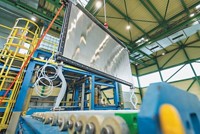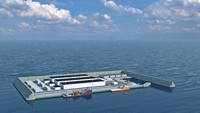Advertisement
Grab your lab coat. Let's get started
Welcome!
Welcome!
Create an account below to get 6 C&EN articles per month, receive newsletters and more - all free.
It seems this is your first time logging in online. Please enter the following information to continue.
As an ACS member you automatically get access to this site. All we need is few more details to create your reading experience.
Not you? Sign in with a different account.
Not you? Sign in with a different account.
ERROR 1
ERROR 1
ERROR 2
ERROR 2
ERROR 2
ERROR 2
ERROR 2
Password and Confirm password must match.
If you have an ACS member number, please enter it here so we can link this account to your membership. (optional)
ERROR 2
ACS values your privacy. By submitting your information, you are gaining access to C&EN and subscribing to our weekly newsletter. We use the information you provide to make your reading experience better, and we will never sell your data to third party members.
Business
Infrastructure: How To Fill Up, On Hydrogen
by Melody M. Bomgardner
November 17, 2014
| A version of this story appeared in
Volume 92, Issue 46

Range anxiety. For many drivers of all-electric vehicles, this psychological condition impinges upon the satisfaction that comes from spending big bucks to decrease one’s carbon footprint. But eco-minded drivers who choose fuel-cell vehicles don’t have to worry about being stranded with a dead battery.
A hydrogen fuel-cell vehicle is a type of electric vehicle. Thanks to the ability to carry around hydrogen, fuel-cell cars can generate enough electricity to travel 400 miles or more without stopping for a fill-up. That’s a comforting margin compared with 66 to 84 miles for the electric Nissan Leaf.
Another bonus: Filling up a tank of hydrogen takes about three minutes, rather than the hours required to recharge an electric-car battery. But finding a station that delivers hydrogen is much more difficult than locating an electrical outlet, at least for now.
Hydrogen fuel stations are beginning to pop up in certain areas of California, Japan, Germany, and the U.K., totaling around three dozen today. They are pricey to install, costing between $1 million and $2 million apiece. And at the moment, they get little use; fuel-cell cars on the road today number in the hundreds. But proponents of fuel-cell transportation acknowledge that the stations must come first.
Thanks to government grants, as well as partnerships of automakers, industrial gas firms, and hydrogen station development companies, many more stations will be operational in 2015 and beyond. “Governments have been very supportive. There is a big driving force to convert to this technology and get infrastructure out there to support the rollout of fuel-cell vehicles,” says Michael Beckman, head of hydrogen fueling at Linde North America.
Last month, Daimler and Linde said they will spend $26 million to install 20 stations in Germany. California currently has nine open stations, with 49 in development, according to the California Fuel Cell Partnership. In May, the California Energy Commission announced $50 million in grants that are funding 28 stations. A major awardee, FirstElement Fuel, also received loan backing from Toyota Motor.
There’s no problem with supplies of hydrogen to stock the stations. Industrial gas firms such as Linde, Air Products & Chemicals, and Air Liquide stand ready to meet demand. But most of those fill-ups of hydrogen will be made from fossil fuel—specifically natural gas via the steam reforming of methane.
“This is the number one concern that we hear from many people: ‘It’s only emission-free if hydrogen comes from renewable sources,’ they say, and it’s a fully valid point,” says Matthias Gebert, product manager for fuel-cell membranes at chemical maker Solvay.
Experts envision a few routes to renewable hydrogen production. For instance, methane captured from organic waste can take the place of gas from underground, Linde’s Beckman points out.
Another option is to electrolyze water into hydrogen—with devices closely related to fuel cells—using renewable but intermittent energy sources such as solar or wind. Gebert sees this happening within a decade or two. “The clean well-to-wheel energy chain will thus become complete,” he says.




Join the conversation
Contact the reporter
Submit a Letter to the Editor for publication
Engage with us on Twitter